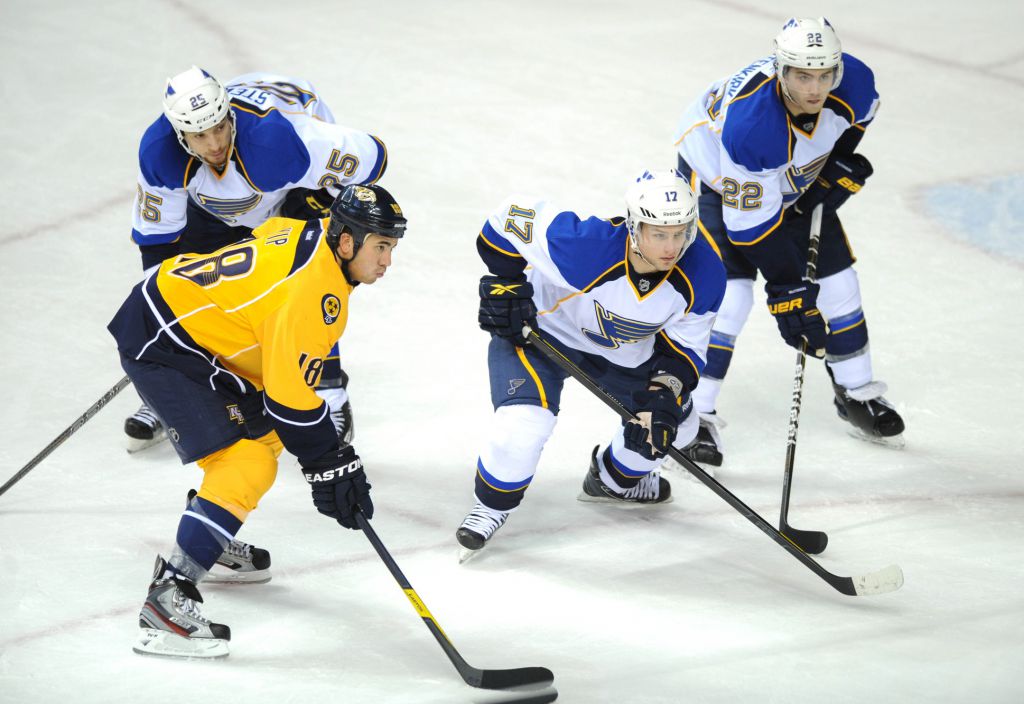A little under three and a half years ago, the St. Louis Blues completed a trade that saw the 1st overall pick from the 2006 NHL Draft, Erik Johnson, shipped to the Colorado Avalanche, just two and a half seasons into his NHL career.
At the time it was viewed as a shock for the Blues to give up the immensely talented, 6’4” defenseman so early in his career, especially with Alex Pietrangelo now in the mix to partner with him for the future.
Instead, the Blues decided that an offensive upgrade was needed, and on February 19, 2011, Johnson was traded to the Avalanche for a combination of picks and young players. It’s time to take a look back on the deal, and assess the outcome.
The Trade:
The Colorado Avalanche acquire Erik Johnson, Jay McClement, and a 2011 or 2012 conditional 1st round pick (2011 #11- Duncan Siemens) from the St. Louis Blues in exchange for Kevin Shattenkirk, Chris Stewart, and a 2011 or 2012 conditional 2nd round pick (2011 #32 Ty Rattie).
The Breakdown:
Erik Johnson: Johnson was the biggest chip dealt in this trade, and up until last season, it looked like he was on his way to becoming a bust. Over his first two and a half seasons with the Avalanche, Johnson only managed to total seven goals and 40 points in 126 games, a major step back from the production he was accustomed to during his first two and a half years in the league when he scored 20 goals and 91 points in 203 games with the Blues. Part of the regression was due to injury, with also confidence and a decreased puck possession role playing a part. However, this past season under new head coach Patrick Roy, Johnson appeared to return to his old self, tallying nine goals and 39 points in 80 games. On top of the offensive production, Johnson also led the team in minutes (23:00 per game) and was second, behind Jan Hejda, in blocked shots (130).
Johnson signed a four-year, $15 million contract with the Avalanche that started in the 2012-13 season that will see him stay with the team until he becomes a UFA in 2016.
Jay McClement: Best known for his abilities to win face-offs and kill penalties, McClement was brought in to Colorado to do just that. During the 2011-12 season (his only full season with the team), McClement stabilized the teams PK unit, finishing 12th in the league, killing 83 per cent of penalties (up from 30th in the league killing only 76.1 per cent the previous year).
McClement left via free agency to the Toronto Maple Leafs after the 2011-12 season.
Duncan Siemens: The Blues 2011 1st round pick, which eventually became Siemens, has yet to factor into this trade. With zero games of NHL experience it’s hard to judge what the Avalanche have in him. The 20-year old Siemens spent last season in the AHL, totaling one goal and four points in 46 games.
Siemens has two years left on his entry level contract and will become a RFA in 2017.
Kevin Shattenkirk: Shattenkirk burst into the NHL with the Avalanche in the 2010-11 season, scoring seven goals and 26 points as a rookie in 46 games before his trade to the Blues. As a member of St. Louis, he continued his impressive offensive performance, playing another 26 games while collecting two more goals and 17 more points to bring his totals to nine goals and 43 points in 72 games for the year. The next season, Shattenkirk matched those numbers exactly, this time in 81 games. The lockout shortened season saw him total five goals and 23 points in 48 games, with last year bringing in 10 goals and 45 points in 81 games. The point being made here is that Shattenkirk’s offensive contribution is about as steady as it comes. Bringing in roughly 45 points a year certainly helped the Blues immediately deal with Johnson’s departure.
Shattenkirk signed a four-year, $17 million deal with the Blues that started during the 2013-14 season and continues until he becomes a UFA in 2017.
Chris Stewart: Coming off a season which saw Stewart score 28 goals and 64 points in 77 games the year before the trade, the then 22-year old power forward was viewed as the biggest piece coming back to the Blues in the trade. After collecting 13 goals and 30 points in 36 games during the 2010-11 season before coming to the Blues, Stewart added 15 more goals and 23 more points in 26 games to bring his totals to 28 goals and 53 points in 62 games for the year. During those two seasons Stewart established himself as one of the better young, scoring power forwards in the NHL, however, that wasn’t the story over the next three seasons. During the next three years with the team, Stewart managed to only collect 48 goals and 92 points in 185 games.
Stewart was traded to the Buffalo Sabres, along with Jaroslav Halak, Williams Carrier, a 2015 1st round pick and a 2016 3rd round pick in exchange for Ryan Miller and Steve Ott. Miller left in free agency for the Vancouver Canucks this offseason, leaving only Steve Ott as the remaining player acquired for Stewart and the other pieces.
Ty Rattie: As a 20-year old, Rattie spent most of his first professional season in the AHL last year (totaling 31 goals and 48 points in 72 games) and played in two NHL games. Despite his lack of NHL experience, all signs point to a promising scoring career for Rattie. He dominated the WHL for his final two years with the Portland Winterhawks, scoring 105 goals and 231 points in 131 games during the regular season and 39 goals and 69 points in 42 playoff games. If it wasn’t for a log-jam at forward, Rattie would be all but guaranteed a spot on the Blues next season. However, with the talent they already have up front and the ability to send Rattie down, don’t be surprised to see him back in the AHL.
Rattie has two years remaining on his entry level deal before becoming a RFA in 2016.
The Winner:
St. Louis, by a small margin.
Three years later, the trade has proved to be a useful one for both sides. Colorado got their all-around number one defenseman that they had been searching for in Johnson (after some less than impressive seasons), and the Blues got an excellent puck mover in Shattenkirk, along with a top notch offensive prospect in Rattie. If Siemens progresses into a legitimate NHL defenseman, this trade may be a little more even, but as it stands St. Louis is the winner in my eyes (even after losing Stewart for almost nothing). On top of the obvious fact that the Blues won because they got both Rattie and Shattenkirk, another major reason I list them as the winners is because it allowed Pietrangelo to blossom into one of the best defenseman in the NHL once Johnson was gone. Who knows, had he stayed it may have stunted Pietrangelo’s development.
Both teams are in a good position heading forward and this trade certainly helped that.
Written by Greg Stamper, who can be found on twitter @g_stamp91




